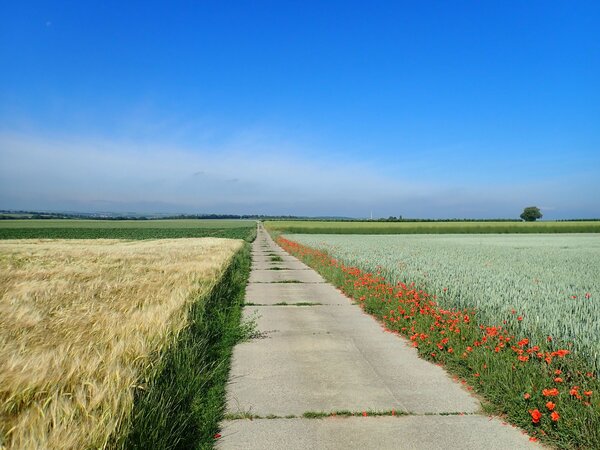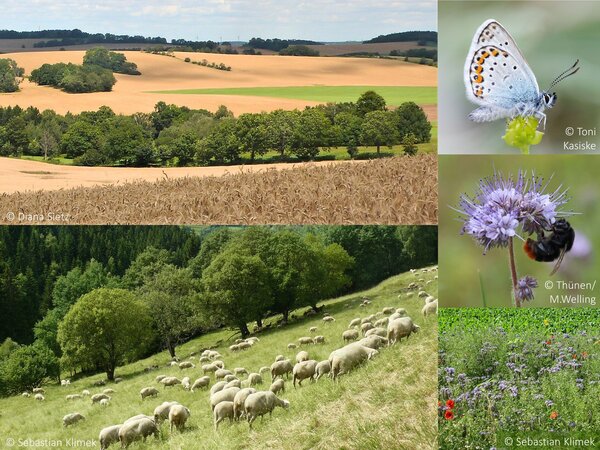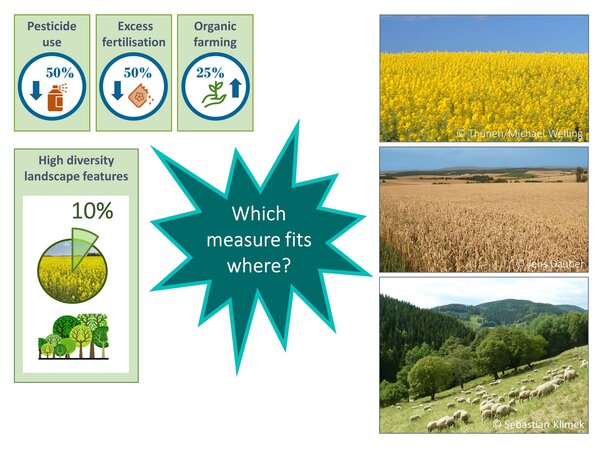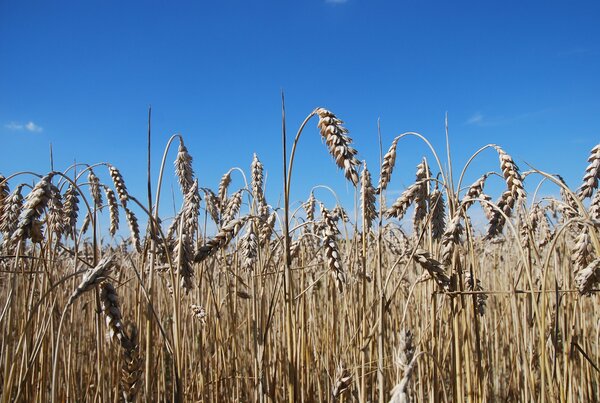Transformative Vision and Pathways

In order to increase the effectiveness and efficiency of agri-environmental measures, differentiated transformative vision and underpinning pathways are developed for different agricultural areas and transformation pathways are tailored to the characteristics of the agricultural land systems. The transformation pathways show how biodiversity can be effectively restored in agricultural landscapes while ensuring sufficient food production. They underline the potential of agricultural landscapes in which biodiversity and agricultural production complement each other in a meaningful way. The transformation pathways include concrete steps for respectively adapted agricultural production systems that are guided by agroecological principles and practices and take into account the habitat requirements of the species to be promoted.
Agroecology has established itself as a guiding approach in the debate on the transformation of our global agricultural and food systems. It aims to promote biodiversity in agriculture, diversify agricultural production (e.g. mixed crops, crop rotations), use resources (e.g. fertiliser and labour) efficiently and create synergies (e.g. agroforestry). At the same time, it promotes closed cycles and resilience to disturbances (e.g. locally adapted, drought-resistant crop varieties). The results of soil biology research are directly incorporated into recommendations for farmers on innovative and new measures that serve the sustainability of agricultural production systems and promote soil biodiversity. Here, this work area links the work areas "agro-system ecology" and "landscape ecology", because the rich experience on the effective implementation of agro-ecological practices gained in these two work areas forms an essential basis for the design of transformation paths specific to agricultural areas. In addition, a close exchange with the working area "Monitoring and Indicators" aims to provide a scientifically sound picture of the state and trends of biodiversity and the underlying processes, differentiated by agricultural land systems. As a conceptual basis for the monitoring of biodiversity in agricultural landscapes, we are developing a typification of agricultural areas in Germany, which should allow us in future to make statements on the state and development of biodiversity specific to agricultural land systems.
The development of land-specific models and target images as well as biodiversity targets tailored to them should enable us to adapt agro-environmental policy support instruments to regional and local socio-ecological framework conditions and to monitor their effectiveness on the basis of agro-region-specific indicators.
The results from this work area are used for policy impact assessment in the agricultural sector at national (Germany), European (EU) and global (FAO) level.
Responsible Scientists:Jens Dauber, Sebastian Klimek, Christian Levers, Diana Sietz
Current topics
Adapted target images and transformation pathways can stimulate agroecological action and policy for biodiversity promotion.
Responsible scientists: Jens Dauber, Sebastian Klimek, Diana Sietz

Convincing target images, which are intended to be effective in guiding action, show how biodiversity and agriculture ideally complement each other effectively in Germany. Based on a typification of Germany's agricultural land systems and the specific cause-effect relationships between agricultural production and biodiversity, target images specific to agricultural areas are developed. They describe a future desired state of biodiversity and ecosystem services in agriculture together with a necessary transformation, i.e. a sustainable conversion of agricultural production systems and agricultural landscapes. Future transformation paths are adapted to the characteristics of the types of agricultural areas.
In order to underpin the agro-space-specific pathways with concrete steps, we develop directional management approaches that are guided by agro-ecological principles and practices. These are context-specific and aim, among other things, to diversify agricultural production (e.g. mixed crops, crop rotations), use resources such as fertiliser and labour efficiently, and create synergies (e.g. agroforestry systems). The management approaches are tailored to the types of agricultural areas in such a way that they consider
- the current level of agricultural production,
- the current state of biodiversity; and
- the underlying cause-effect relationships.
Clearly defined target images and transformation pathways should make it possible to effectively implement biodiversity-promoting measures and to align monitoring with relevant cause-effect relationships. The target images help to assess whether and under which conditions existing biodiversity and agricultural policies provide effective incentives to sustainably transform Germany's agricultural land systems. Adapted indicator sets are being developed for monitoring biodiversity in agricultural landscapes. They are used to check whether the desired progress is being achieved.
Archetype analysis offers great opportunities to facilitate a sustainable re-design of Germany’s agricultural land systems by identifying regions with potentially similar transformative approaches, allowing the development of context-specific and effective policy measures. We identify archetypes that reveal recurrent patterns in the interactions between agriculture, biodiversity and other agricultural land system properties. Archetypes can support the tailoring of policy measures to recurrent cause-effect schemes and focussing action to the most promising regions helping to increase policies effectiveness.
Responsible scientists: Christian Levers, Diana Sietz

Implementing agricultural and biodiversity policies uniformly at the national level undermines their effectiveness, e.g. in protecting farmland birds and pollinators. The limited effectiveness can be attributed to the pronounced variability in agricultural land systems including relationships between agriculture and farmland biodiversity. However, patterns in this variability offer opportunities to tailor policy measures to recurrent configurations of factors and processes helping to focus actions to the most promising regions. As a way forward, archetype analysis can provide insights into recurrent patterns in the interactions between agriculture, biodiversity, resource use decisions and governance, among others, and transformative potential. Archetypes provide synthesised knowledge at an intermediate level of abstraction. This synthesised knowledge can help to tailor policy measures and transformative pathways to recurrent characteristics of agricultural land systems helping policies to achieve their objectives more effectively. Archetype analysis facilitates the engagement of stakeholders and promotes the transfer and out/up-scaling of sustainable practices.
Archetype analysis focuses on identifying co-occurring patterns and trends within agricultural land systems revealing common characteristics and behaviours at regional scale. Being aware of these patterns and trends, as well as where they play out geographically, allows for the tailoring of interventions and the design of future development pathways and related transformative goals. Archetypes can be tracked over time, helping in monitoring and evaluating the effectiveness of policy measures and can guide adaptive management approaches to ensure transformative changes are on track. This provides a particular advantage for efforts aimed at out/up-scaling sustainable agricultural practices as regions with similar characteristics offer opportunities to transfer and out/up-scale practices that proved to be successful in individual regions. Identification of patterns in agricultural land systems and changes therein can facilitate an effective stakeholder engagement by providing a common language and framework for discussions and knowledge transfer. This strengthens the evidence base to inform policy and decision-making fostering the design of targeted policies, regulations, and interventions that promote sustainable agriculture.
In this research topic, we address the following overarching research question:
- Which archetypical interactions between agriculture, biodiversity, resource use decisions and governance, among others, differentiate agricultural land systems in Germany?
- What are biodiversity patterns and trends of archetypical agricultural landscapes in Germany?
- Where lies potential to transfer and out/up-scale successful measures to halt/reverse biodiversity decline?
- Which tailored pathways can support a sustainability transition of Germany’s archetypical agricultural landscapes?
Global food security is one of the main arguments why measures to protect and restore biodiversity are not effectively implemented in Germany. However, the strong focus of the debate on yields and production volumes as guarantors of food security is highly questionable in view of the political goals for climate and biodiversity. We therefore question this narrow focus and put the arguments to the scientific test.
Responsible scientists: Jens Dauber, Christian Levers

Agricultural practices that minimise the impact of production systems on the natural environment and on biodiversity in particular, such as those used in organic farming and agroecology, are assumed to lead to lower yields. Assuming stable demand, it is assumed that this production deficit triggers imports from other production regions, leading to offsetting impacts on biodiversity there. In such telecoupled systems, high yields are assumed to lead to positive net impacts on biodiversity, as production is concentrated on a smaller area, sparing natural vegetation from conversion to agricultural land and thus contributing to habitats for intact ecological systems. However, this assumption does not hold true in reality due to rebound effects (see: Jevon's paradox). Furthermore, a large part of German crop production is used as livestock feed and not for direct human consumption, thus contributing only indirectly to food security. Another problem is the low conversion efficiency, which leads to a loss of macro- and micronutrients.
The expected decline in yields and production volume in connection with the transition to diversified and nature-friendly agricultural production is cited as one of the main arguments against this transition. The one-sided consideration of production and the associated profits neglects important negative externalities of yield-oriented agricultural systems. Clearly, we cannot continue with our current role model for agricultural production systems in the face of the ongoing climate and biodiversity crisis. How can it be justified that important steps in agricultural landscapes to improve NCP and biodiversity are not taken in the face of this focus on yields and profits? How valid is this assumption and how can we demonstrate that other solutions are possible that balance production with the maintenance and enhancement of ecological functions and biodiversity?
In this research topic, we are investigating this problem in cooperation with other Thünen institutes on the basis of the following research questions:
- How can the trade-offs between global food security and biodiversity conservation be effectively addressed in German agriculture, and what strategies can be used to achieve both goals simultaneously?
- What is the national biodiversity footprint of agricultural production that goes directly and indirectly (or not) into human food consumption?
- What are the possible future trends and scenarios for the German agricultural sector, and how might they affect global food security and biodiversity in the long term?

![[Translate to English:] [Translate to English:]](/media/_processed_/e/3/csm_Demetra2_c8a192c0f8.jpg)
![[Translate to English:] [Translate to English:]](/media/_processed_/e/2/csm_Demetra1_Panorama_8557ee3b13.jpg)





